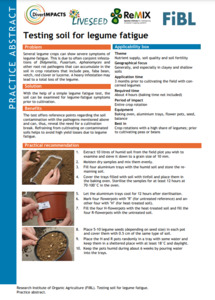{Tool} Testing soil for legume fatigue (DiverIMPACTS, ReMIX, LIVESEED Practice Abstract). Creator(s): Fuchs, Jacques; Hohmann, Pierre; Wilbois, Klaus-Peter; Conder, Malgorzarta; Gelencsér, Tobias and Weidmann, Gilles. Issuing Organisation(s): FiBL - Research Institute of Organic Agriculture. DiverIMPACTS, ReMIX, LIVESEED Practice abstract. (2021)
|
PDF
- English
(Testing soil for legume fatigue)
358kB | |
![[thumbnail of DiverIMPACTS_PA_Testing_Soil_For_Legume_Fatigue.png]](/41891/3.hassmallThumbnailVersion/DiverIMPACTS_PA_Testing_Soil_For_Legume_Fatigue.png)  Preview |
Image (PNG)
- Cover Image
- English
289kB |
|
PDF
- Published Version
- French/Francais
408kB |
Document available online at: https://zenodo.org/record/4421457#.YSd6PY4zaUk
Summary in the original language of the document
Benefits
The test offers reference points regarding the soil contamination with the pathogens mentioned above and can, thus, reveal the need for a cultivation break. Refraining from cultivating on contaminated soils helps to avoid high yield losses due to legume fatigue.
Practical recommendation
1. Extract 10 litres of humid soil from the field plot you wish to examine and sieve it down to a grain size of 10 mm.
2. Moisten dry samples and mix them evenly.
3. Fill four aluminium trays with the humid soil and store the re-maining soil.
4. Cover the trays filled with soil with tinfoil and place them in the baking oven. Sterilise the samples for at least 12 hours at 70-100°C in the oven.
5. Let the aluminium trays cool for 12 hours after sterilisation.
6. Mark four flowerpots with "R" (for untreated reference) and an-other four with "H" (for heat-treated soil).
7. Fill the four H-flowerpots with the heat-treated soil and fill the four R-flowerpots with the untreated soil.
8. Place 5-10 legume seeds (depending on seed size) in each pot and cover them with 0.5 cm of the same type of soil.
9. Place the H and R pots randomly in a tray with some water and keep them in a sheltered place with at least 18°C and daylight.
10. Keep the pots humid during about 6 weeks by pouring water into the trays.
Practical testing
- After about 6 weeks, the test can be evaluated. If the reference plants have germination problems and/or are growing poorly and turning yellow due to heavy infestation, the evaluation can take place earlier.
- For evaluation, cut all plant shoots at the stem 2 cm above the soil, and weigh the shoots of each pot separately. Make a note of the shoots' weight.
- Dividing the weight of the untreated reference plants by the weight of the plants from the heat-treated soil gives a ratio which can be used as an indicator for legume fatigue.
- For example, if the weight of the plants in the untreated soil is 180 g and the weight of the plants with the heat-treated soil is 200 g, then; 180 g/200 g = a ratio of 0.9.
| EPrint Type: | Practice tool |
|---|---|
| What problem does the tool address?: | Several legume crops can show severe symptoms of legume fatigue. This is due to often conjoint infesta-tions of Didymella, Fusarium, Aphanomyces and other root rot pathogens that can accumulate in the soil in crop rotations that include pea, faba bean, vetch, red clover or lucerne. A heavy infestation may lead to a total loss of the legume. |
| What solution does the tool offer?: | With the help of a simple legume fatigue test, the soil can be examined for legume-fatigue symptoms prior to cultivation. |
| Country: | Switzerland |
| Type of Practice Tool: | Practice abstracts |
| Keywords: | legumes, intercropping, crop rotation, faba beans, peas, soil quality, soil fertility, nutrient supply |
| Agrovoc keywords: | Language Value URI English legumes http://aims.fao.org/aos/agrovoc/c_4255 English intercropping http://aims.fao.org/aos/agrovoc/c_3910 English crop rotation http://aims.fao.org/aos/agrovoc/c_6662 English faba beans http://aims.fao.org/aos/agrovoc/c_10722 English peas http://aims.fao.org/aos/agrovoc/c_13177 English soil quality http://aims.fao.org/aos/agrovoc/c_a9645d28 English soil fertility UNSPECIFIED |
| Subjects: | Crop husbandry > Crop combinations and interactions Crop husbandry > Production systems > Cereals, pulses and oilseeds Crop husbandry > Crop health, quality, protection |
| Research affiliation: | Switzerland > FiBL - Research Institute of Organic Agriculture Switzerland > Crops > Anbautechnik > Crop rotations Switzerland > FiBL - Research Institute of Organic Agriculture Switzerland > Crops > Arable crops > Legumes Switzerland > FiBL - Research Institute of Organic Agriculture Switzerland > Crops > Anbautechnik > Mixed cropping European Union > Horizon 2020 > Diverimpacts European Union > Horizon 2020 > Liveseed European Union > Horizon 2020 > Liveseed > Liveseed tools European Union > Horizon 2020 > Remix European Union > Organic Farm Knowledge |
| Horizon Europe or H2020 Grant Agreement Number: | 727482 |
| Related Links: | https://www.diverimpacts.net/, https://www.liveseed.eu/, https://www.remix-intercrops.eu/, https://organic-farmknowledge.org/tool/41891, https://zenodo.org/record/4421457#.YSd6PY4zaUk, https://orgprints.org/id/eprint/31023/, https://www.facebook.com/organicfarmknowledge/posts/330301815549126, https://twitter.com/farm_knowledge/status/1433719182907133956 |
| Project ID: | ofk |
| Deposited By: | Forschungsinstitut für biologischen Landbau, FiBL |
| ID Code: | 41891 |
| Deposited On: | 26 Aug 2021 11:38 |
| Last Modified: | 02 May 2024 10:32 |
| Document Language: | English, French/Francais |
| Status: | Published |
Repository Staff Only: item control page

 Download Statistics
Download Statistics Download Statistics
Download Statistics
